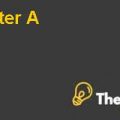Inconsistency in Research Approach Case Study Solution
Missing Tables:
Normally in researches, to explain the analysis of the data and its results, writer firstly inserts the summary table of his findings and then interprets it by using the hypothesis for the research questions. But here the data and its results are not entered before interpreting it. This is helpful for the readers of the research paper that he will see the tables in front of their eyes and evaluating the interpretation one by one for all questions. In this type of presentations of research papers, do not hesitate and irritate the readers because it removed the step for the readers to go down the research paper to see the exhibits and appendix after every one minute to understand the interpretation of every questions of research paper.
Missing APA Style of Table:
In the research papers, we need to refer the text or interpretation with their table number. Like if you interpret question number one, then you need to put the summary table of this question before the interpretation of it and put the detailed information in the exhibits which a writer will refer the exhibit or appendix number while during interpretation.
Violation of Word Count Limit:
In a research papers, the minimum word count limit is 8,000 words. This research report is consisting of only 1,700 words, which is the violation of a word count limit.
Data Normality Issue:
In this research paper, data is very short. The sample size of data is consisting of only 60 adolescences, which will raise the normality issue in the data set. To confirm the normality of the data set, your data must be consists of at least 284 participants. Due to the small data set, there would be a normality issue in the data set.
1st Hypothesis:
In this research paper, after following the research questions, I found that the hypothesis is not made properly according to the research questions. There are two issues in the hypothesis;
- The hypothesis are not made according to the hypothesis style, the hypothesis is looking like a question rather than a scenario.
- The test which the writer had performed to check the results and relationship between these two dependent variables (loneliness and participation rate) for two groups is wrong.
The null hypothesis should be that the mean value of depended variables participation and loneliness is same for DCD and Control groups. Ultimately the alternative hypothesis will be that the mean value of dependent variables participation and loneliness is not same for DCD and Control groups.
Here, to check this null hypothesis, there is a need for one way anova test to check the results of this hypothesis and interpretations. In Appendix 1, Anova table shows that the mean value of dependent variable participation is same for DCD and Control groups at the 5% confidence level because the p-value is greater than 0.05, here we do not found the statistically significant evidences to reject the null hypothesis which tells that the mean value of variable participation is same for DCD and Control groups. But the mean value of dependent variable loneliness is not same for DCD and Control groups at the 5% confidence level because the p-value is less than 0.05, here we found the statistically significant evidences to reject the null hypothesis which tells that the mean value of variable loneliness is same for DCD and Control groups.
2nd Hypothesis:
In this research paper, after following the research questions, I found that the hypothesis is not made properly according to the research questions. There are three issues in the hypothesis;
- The hypothesis are not made according to the hypothesis style, the hypothesis is looking like a question rather than a scenario.
- The test which the writer had performed to check the results of the proportion of BMI is significantly difference between the adolescences with DCD and Control groups is wrong.
- The hypothesis made by the writer is totally wrong, in his hypothesis he is defining the relationship while the hypothesis will be made to check the variances and association between the two groups.
The null hypothesis should be that there is not an association between the two groups (DCD and Control). Ultimately the alternative hypothesis will be that there is an association between the two groups (DCD and Control).
Here, to check this null hypothesis, there is a need for chi square test to check the results of this hypothesis and interpretations. In Appendix 2, Chi square table shows that there is an association between the two groups (DCD and Control) at the 5% confidence level because the p-value is less than 0.05, here we have found the statistically significant evidences to reject the null hypothesis which tells that there is not an association between the two groups (DCD and Control).
Appendix 1: Result of Hypothesis-1
| ANOVA | ||||||
| Sum of Squares | df | Mean Square | F | Sig. | ||
| PARTICIPATION | Between Groups | 461.630 | 1 | 461.630 | 3.605 | .063 |
| Within Groups | 7427.770 | 58 | 128.065 | |||
| Total | 7889.400 | 59 | ||||
| LONELINESS | Between Groups | 2640.233 | 1 | 2640.233 | 11.258 | .001 |
| Within Groups | 13602.167 | 58 | 234.520 | |||
| Total | 16242.400 | 59 | ||||
Appendix 2: Result of Hypothesis-2
| Chi-Square Tests | |||
| Value | df | Asymptotic Significance (2-sided) | |
| Pearson Chi-Square | 17.321a | 2 | .000 |
| Likelihood Ratio | 20.937 | 2 | .000 |
| Linear-by-Linear Association | 16.800 | 1 | .000 |
| N of Valid Cases | 60 | ||
| a. 1 cell (16.7%) has expected count less than 5. The minimum expected count is 4.40. | |||
| GROUP * BMI Group Cross tabulation | |||||
| Count | |||||
| BMI Group | Total | ||||
| 1.00 | 2.00 | 3.00 | |||
| GROUP | DCD | 0a | 9a | 13b | 22 |
| CONTROL | 12a | 21a | 5b | 38 | |
| Total | 12 | 30 | 18 | 60 | |
| Each subscript letter denotes a subset of BMI Group categories whose column proportions do not differ significantly from each other at the .05 level. | |||||












